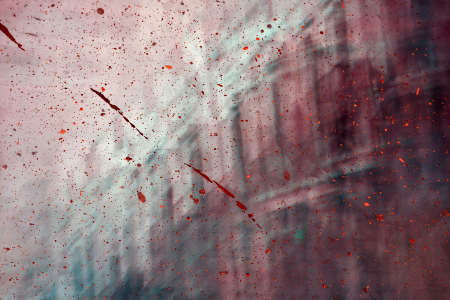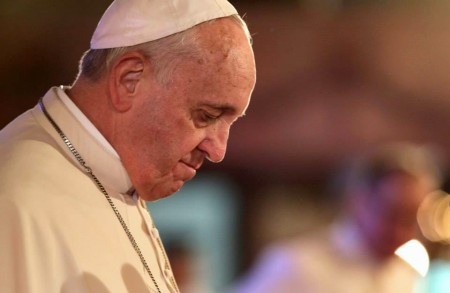We ask you, humbly: don't scroll away.
Hi readers, it seems you use Catholic Online a lot; that's great! It's a little awkward to ask, but we need your help. If you have already donated, we sincerely thank you. We're not salespeople, but we depend on donations averaging $14.76 and fewer than 1% of readers give. If you donate just $5.00, the price of your coffee, Catholic Online School could keep thriving. Thank you.Help Now >
Liturgy: Rose-Colored Vestments on Gaudete Sunday
FREE Catholic Classes
And More on Pre-recorded Music
ROME, DEC. 8, 2004 (Zenit) - Answered by Father Edward McNamara, professor of liturgy at the Regina Apostolorum Pontifical University.
Q: I have always observed that the priest wore a rose or pink vestment on Gaudete Sunday, the third Sunday of Advent. Last year, around this time, our pastor informed us that such a practice was abandoned and, as such, there were no longer any pink vestments nor pink candles during Advent (and that there was a move away from considering Advent a penitential season). But, lo and behold, a visiting priest wore them on the following Sunday, and, when asked, insisted that the practice was never changed. -- RL, Frederick, Maryland
A: Our reader from Maryland (and others) have asked questions regarding the use of rose-colored vestments on Gaudete and Laetare Sundays. The essential norms dealing with the use of liturgical colors are found in the new General Instruction of the Roman Missal, No. 346.
"As to the color of sacred vestments, the traditional usage is to be retained: namely,
"a. White is used in the Offices and Masses during the Easter and Christmas seasons; also on celebrations of the Lord other than of his Passion, of the Blessed Virgin Mary, of the Holy Angels, and of Saints who were not Martyrs; on the Solemnities of All Saints (1 November) and of the Nativity of Saint John the Baptist (24 June); and on the Feasts of Saint John the Evangelist (27 December), of the Chair of Saint Peter (22 February), and of the Conversion of Saint Paul (25 January).
"b. Red is used on Palm Sunday of the Lord's Passion and on Good Friday, on Pentecost Sunday, on celebrations of the Lord's Passion, on the feasts of the Apostles and Evangelists, and on celebrations of Martyr Saints.
"c. Green is used in the Offices and Masses of Ordinary Time.
"d. Violet or purple is used in Advent and of Lent. It may also be worn in Offices and Masses for the Dead (cf. below).
"e. Besides violet, white or black vestments may be worn at funeral services and at other Offices and Masses for the Dead in the Dioceses of the United States of America.
"f. Rose may be used, where it is the practice, on Gaudete Sunday (Third Sunday of Advent) and on Laetare Sunday (Fourth Sunday of Lent).
"g. On more solemn days, sacred vestments may be used that are festive, that is, more precious, even if not of the color of the day.
"h. Gold or silver colored vestments may be worn on more solemn occasions in the dioceses of the United States of America."
To this we may add the observation of the instruction "Redemptionis Sacramentum," Nos. 121 and 127.
[121.] "The purpose of a variety of color of the sacred vestments is to give effective expression even outwardly to the specific character of the mysteries of faith being celebrated and to a sense of Christian life's passage through the course of the liturgical year." On the other hand, the variety of offices in the celebration of the Eucharist is shown outwardly by the diversity of sacred vestments. In fact, these "sacred vestments should also contribute to the beauty of the sacred action itself."
[127.] "A special faculty is given in the liturgical books for using sacred vestments that are festive or more noble on more solemn occasions, even if they are not of the color of the day. However, this faculty, which is specifically intended in reference to vestments made many years ago, with a view to preserving the Church's patrimony, is improperly extended to innovations by which forms and colors are adopted according to the inclination of private individuals, with disregard for traditional practice, while the real sense of this norm is lost to the detriment of the tradition. On the occasion of a feastday, sacred vestments of a gold or silver color can be substituted as appropriate for others of various colors, but not for purple or black."
We ask you, humbly: don't scroll away.
Hi readers, it seems you use Catholic Online a lot; that's great! It's a little awkward to ask, but we need your help. If you have already donated, we sincerely thank you. We're not salespeople, but we depend on donations averaging $14.76 and fewer than 1% of readers give. If you donate just $5.00, the price of your coffee, Catholic Online School could keep thriving. Thank you.Help Now >
From all this it is clear that the custom of using rose-colored vestments on Gaudete and Laetare Sundays is to be maintained whenever possible.
If a parish lacks rose vestments then the usual violet is used.
The names Gaudete and Laetare comes from the traditional entrance antiphon, or introit, sung at these Masses.
Both terms may be broadly translated as "rejoice" or "delight" and refer to the importance of the theme of Christian joy, even in the midst of a penitential season, which is reflected in the formulas and readings of both these Masses.
With respect to liturgical colors, a bishops' conference, above all in mission territories, may seek the Holy See's approval to adopt other colors if the symbolism of the traditional colors would be misunderstood.
In some Asian countries, for example, white is the traditional color of mourning and does not have the festive connotations prevalent in Western society. In such cases the bishops may propose the traditional festive colors of the culture.
While blue is not an official liturgical color, some countries, such as Spain, and some Marian shrines have the privilege of using blue-colored vestments on Marian feasts such as the Immaculate Conception. These are vestments made of blue-colored fabric and not just white or silver vestments with blue trimmings or blue Marian motifs, which may be used everywhere.
Historically it appears that all sacred vestments were white until about the seventh century. Around the time of Pope Innocent III (died 1216) we had four principal colors (red, white, black and green) and three secondary colors (yellow, rose and purple). But a common criterion for the use of the various colors is not found until around 1550, when the present usage became standard.
As "Redemptionis Sacramentum," No. 121, says above, the purpose of using different colors is to express the specific character of the various mysteries. The use of the diverse colors is both pedagogical and symbolic of the various liturgical feasts and seasons.
Thus, white, the symbol of light and purity, and gold and silver are festive colors. Red expresses both the fire of the Holy Spirit and the blood of the Passion and of martyrdom. Green is the symbolic color of hope and serenity.
Violet, recalling somberness and penance, has also largely replaced black for funerals although this latter color may still be used. Rose, which has never enjoyed frequent use, serves as a reminder, by using an unusual color, that we are halfway through a penitential season.
* * *
Follow-up: Pre-recorded Music
As a corollary to our column on pre-recorded music at Mass (Nov. 23) a reader from Taiwan asked a question regarding pre-set accompaniment to live singing.
Certainly the Italian norms, forbidding recorded music, mentioned in the former column where written in the era of the vinyl disc and early cassettes, and could not contemplate the possibility possessed by most modern organs to set certain accompaniment.
I would say that, although the ideal remains having the organ played by a musician who forms part of the assembly, in some circumstances it may be legitimate to use the instrument's ability to be pre-set in order to support and sustain, but never to substitute, assembly singing.
A Nigerian correspondent asked if, due to the dearth of musically literate parishioners, it were a legitimate option to hire professional musicians to play the organ or other instruments even though they may be non-Catholic.
Once more I would say that although the musicians should form part of the assembly, and hence be practicing Catholics, there may be circumstances when this is not possible and a parish must recur to the services of non-Catholic professionals in order to support the liturgical participation of the faithful.
In such cases, great care must be taken to ensure that the musician understands the sacred nature of the music to be played and to avoid musical virtuosities and other elements that smack of public concert performances.
The latter criterion, needless to say, is also valid for Catholic musicians.
They should likewise always be in a supportive role with respect to the choir and the rest of the assembly. For the purpose of good liturgical music is to foster the active participation of the assembly, at times through joining in the song and at times by meditatively listening to music while uniting heart and soul to God.
As far as I know, there is no official document that forbids the use of non-Catholic musicians in the above-mentioned circumstances or on very special occasions, provided the use is limited and the music played is genuinely Catholic.
In 1988 I remember participating at a Mass in St. Peter's Basilica, presided over by Cardinal Joseph Ratzinger but attended by the Holy Father, in which Rome's German community celebrated the 10th anniversary of the pontificate with a thanksgiving Mass accompanied by a major German orchestra and choir that sang Beethoven's Missa Solemnis.
Certainly not all of the musicians were Catholic. But the Mass and the Music certainly were.
We ask you, humbly: don't scroll away.
Hi readers, it seems you use Catholic Online a lot; that's great! It's a little awkward to ask, but we need your help. If you have already donated, we sincerely thank you. We're not salespeople, but we depend on donations averaging $14.76 and fewer than 1% of readers give. If you donate just $5.00, the price of your coffee, Catholic Online School could keep thriving. Thank you.Help Now >
Contact
Catholic Online
https://www.catholic.org
CA, US
Catholic Online - Publisher, 661 869-1000
info@yourcatholicvoice.org
Keywords
Liturgy, Garments, Vestments, Gaudete, Mass, Priest
More Catholic PRWire
Showing 1 - 50 of 4,716
A Recession Antidote
Randy Hain
Monaco & The Vatican: Monaco's Grace Kelly Exhibit to Rome--A Review of Monegasque-Holy See Diplomatic History
Dna. Maria St. Catherine Sharpe, t.o.s.m., T.O.SS.T.
The Why of Jesus' Death: A Pauline Perspective
Jerom Paul
A Royal Betrayal: Catholic Monaco Liberalizes Abortion
Dna. Maria St.Catherine De Grace Sharpe, t.o.s.m., T.O.SS.T.
Embrace every moment as sacred time
Mary Regina Morrell
My Dad
JoMarie Grinkiewicz
Letting go is simple wisdom with divine potential
Mary Regina Morrell
Father Lombardi's Address on Catholic Media
Catholic Online
Pope's Words to Pontifical Latin American College
Catholic Online
Prelate: Genetics Needs a Conscience
Catholic Online
State Aid for Catholic Schools: Help or Hindrance?
Catholic Online
Scorsese Planning Movie on Japanese Martyrs
Catholic Online
2 Nuns Kidnapped in Kenya Set Free
Catholic Online
Holy See-Israel Negotiation Moves Forward
Catholic Online
Franchising to Evangelize
Catholic Online
Catholics Decry Anti-Christianity in Israel
Catholic Online
Pope and Gordon Brown Meet About Development Aid
Catholic Online
Pontiff Backs Latin America's Continental Mission
Catholic Online
Cardinal Warns Against Anti-Catholic Education
Catholic Online
Full Circle
Robert Gieb
Three words to a deeper faith
Paul Sposite
Relections for Lent 2009
chris anthony
Wisdom lies beyond the surface of life
Mary Regina Morrell
World Food Program Director on Lent
Catholic Online
Moral Clarity
DAN SHEA
Pope's Lenten Message for 2009
Catholic Online
A Prayer for Monaco: Remembering the Faith Legacy of Prince Rainier III & Princess Grace and Contemplating the Moral Challenges of Prince Albert II
Dna. Maria St. Catherine Sharpe
Keeping a Lid on Permissiveness
Sally Connolly
Glimpse of Me
Sarah Reinhard
The 3 stages of life
Michele Szekely
Sex and the Married Woman
Cheryl Dickow
A Catholic Woman Returns to the Church
Cheryl Dickow
Modernity & Morality
Dan Shea
Just a Minute
Sarah Reinhard
Catholic identity ... triumphant reemergence!
Hugh McNichol
Edging God Out
Paul Sposite
Burying a St. Joseph Statue
Cheryl Dickow
George Bush Speaks on Papal Visit
Catholic Online
Sometimes moving forward means moving the canoe
Mary Regina Morrell
Action Changes Things: Teaching our Kids about Community Service
Lisa Hendey
Easter... A Way of Life
Paul Spoisite
Papal initiative...peace and harmony!
Hugh McNichol
Proclaim the mysteries of the Resurrection!
Hugh McNichol
Jerusalem Patriarch's Easter Message
Catholic Online
Good Friday Sermon of Father Cantalamessa
Catholic Online
Papal Address at the End of the Way of the Cross
Catholic Online
Cardinal Zen's Meditations for Via Crucis
Catholic Online
Interview With Vatican Aide on Jewish-Catholic Relations
Catholic Online
Pope Benedict XVI On the Easter Triduum
Catholic Online
Holy Saturday...anticipation!
Hugh McNichol
 Hi readers, it seems you use Catholic Online a lot; that's great! It's a little awkward to ask, but we need your help. If you have already donated, we sincerely thank you. We're not salespeople, but we depend on donations averaging $14.76 and fewer than 1% of readers give. If you donate just $5.00, the price of your coffee, Catholic Online School could keep thriving. Thank you. Help Now >
Hi readers, it seems you use Catholic Online a lot; that's great! It's a little awkward to ask, but we need your help. If you have already donated, we sincerely thank you. We're not salespeople, but we depend on donations averaging $14.76 and fewer than 1% of readers give. If you donate just $5.00, the price of your coffee, Catholic Online School could keep thriving. Thank you. Help Now >











 Daily Readings for Saturday, April 20, 2024
Daily Readings for Saturday, April 20, 2024 St. Marian: Saint of the Day for Saturday, April 20, 2024
St. Marian: Saint of the Day for Saturday, April 20, 2024 Children's Prayer For Parents: Prayer of the Day for Saturday, April 20, 2024
Children's Prayer For Parents: Prayer of the Day for Saturday, April 20, 2024


